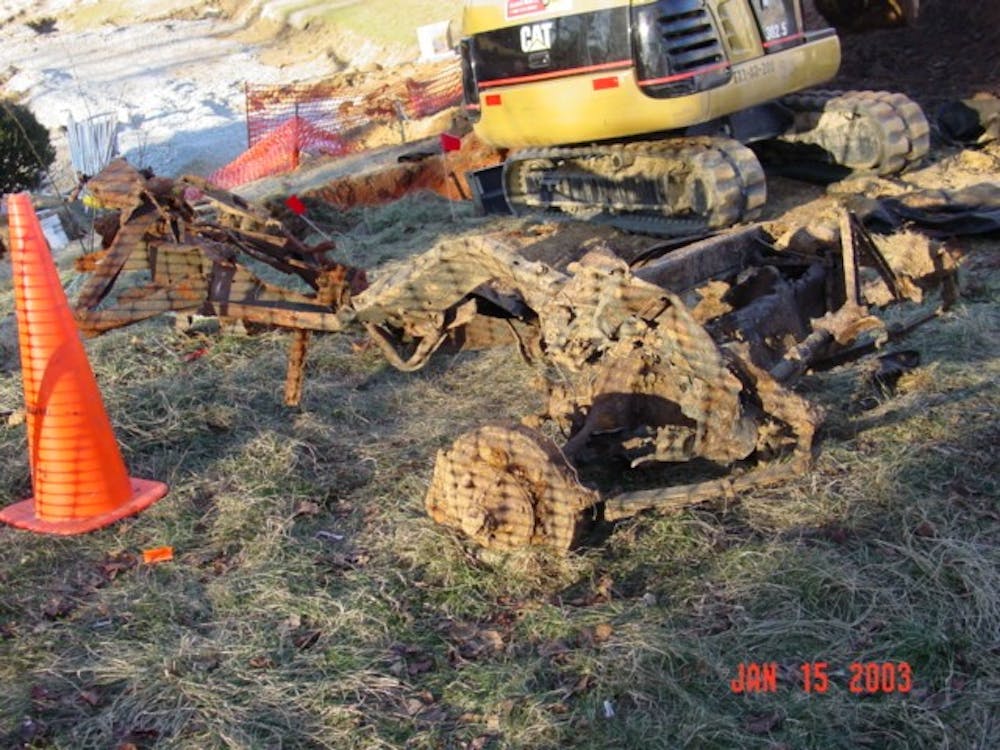This story is the sixth in a seven-part series investigating World War I-era chemical weapons and equipment buried under AU’s campus and in the Spring Valley neighborhood.
The Army Corps of Engineers’ contractors were excavating World War I chemicals on the South side of campus in 2003 when they made a puzzling discovery.
Near the Child Development Center, the Army Corps unearthed the rusted frame of a four-door sedan, manufactured in the 1920s.
Some in the AU community believe the car was a Ford Model T, a popular automobile at the time, but according to Army Corps historian Mark Baker, the car was actually a Willys-Knight, produced by a now-defunct Ohio company.
The Army Corps found the car when they were looking for pieces of metal that could have been World War I munitions, Baker said.
In the late 1910s, the Army disposed of projectiles and lab equipment at the edge of campus by burying them. The car, however, was an unexpected find.
“We don’t know why it was buried or why it was buried there,” Baker said.
The Army Corps’ dig was part of a larger 2001 effort to clean up arsenic-contaminated soil near the Child Development Center.
Arsenic is a naturally occurring chemical that can be poisonous if it builds up in the body. It was an essential ingredient to many of the laboratory experiments conducted at AU during World War I.
Arsenic makes up 30 percent of the chemical lewisite, a chemical weapon that causes large, painful blisters and irritates the lungs. Lewisite was first created at Catholic University and then manufactured at AU during the war.
The center was closed from 2001 to 2009, after the Army Corps found elevated levels of arsenic in the soil around the building and on the intramural field — once known as the “arsenic field,” The Eagle previously reported.
In 2001, a health-consulting firm hired by AU tested 68 children, AU grounds crew members and student rugby players for arsenic poisoning.
Members of the rugby team had unusual rashes that would not completely heal.
The 27 children tested had been playing in the vegetable garden at the Child Development Center, a possible site for arsenic.
The tests concluded that the subjects, who spent hours each day near contaminated soil, had arsenic levels within a normal range.
In March of this year, AU chemistry professor James Girard gave a lecture on the history of World War I chemicals on campus. He believes they shouldn’t be a problem.
“All arsenic was removed from campus 10 years ago or longer,” Girard said. “I know of no danger to the AU community.”
Chemicals on campus
Arsenic and perchlorate, an ingredient in rocket fuel, have been the Army Corps’ two main chemical concerns for the AU campus.
Years of the Army Corps’ perchlorate testing have revealed a concentration of 146 parts per billion in the groundwater near the Kreeger Building. The Environmental Protection Agency’s safety standard for perchlorate is 15 parts per billion.
Though the Army Corps’ testing wells detected the chemical, they are not sure where it is coming from.
Locating the perchlorate source would be valuable, but may not be feasible, Army Corps Project Manager Dan Noble said at a February 2010 Restoration Advisory Board meeting. Noble also said the levels of perchlorate on campus have been steady or declining.
Spring Valley residents have been at odds with Army Corps members at meetings like these since cleanup progress began in the 1990s.
Residents are concerned that the Army Corps has not been thorough in its search or excavation of World War I artifacts, and that the Army Corps has hidden test results that would harm its credibility.
In 1995, the Army Corps issued a public cleanup report that said, “There are no risks posed by hazardous substances that exceed acceptable risk levels for human health or the environment.”
But in 2001, they found the elevated levels of arsenic at the Child Development Center.
At the site where the Willys-Knight was excavated in 2003, the Army Corps also found over 1,000 pieces of laboratory glassware, projectiles, munitions, a bottle of lewisite, several bombs, lead, mercury and arsenic.
The Army Corps identified the site as one of several “disposal areas,” where chemicals and lab equipment would have been thrown away during Army engineers’ World War I experiments.
“The Army Corps said they finished the cleanup ahead of schedule and under budget, but after a heavy rainstorm, the sidewall of the pit collapsed, exposing more laboratory glassware,” said local environmentalist Kent Slowinski.
The Army Corps’ cleanup project is ongoing. One of the most-disputed cleanup sites is on AU property: the house of the University’s president.
See the final part of this series in The Eagle’s April 19 issue. To read the first five parts of the series, visit theeagleonline.com/AUatWar.
news@theeagleonline.com





